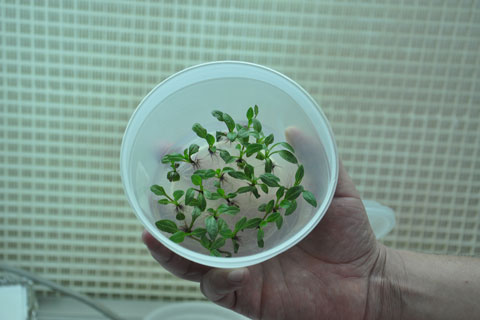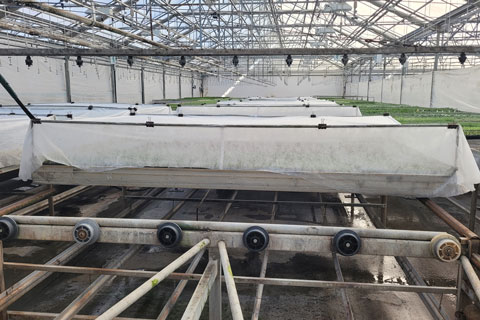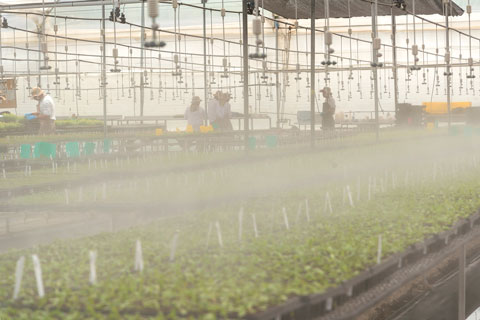8/1/2024
Tissue Culture Echinacea
Chris Fifo
Echinacea from tissue culture (TC) aren’t difficult to establish if certain protocols are followed. The critical factor to understand is that these have been grown in a lab under high humidity, low light and warm temperatures. Lower humidity, higher light levels and temperature extremes should be avoided until the TC has been acclimated.

Arrival & handling
Prior to opening the containers, place the box in a cool room or office. Do not open in a warm or sunny/lighted greenhouse. Be aware of the temperature inside the box upon arrival. If it’s warm (e.g., above 75F/24C), it’s beneficial to remove the containers and place them in a cooler set at 65F (18C) to slowly cool the media before opening.
TC should be planted immediately upon arrival. However, if the TC isn’t going to be planted the same day, remove the vessels from the box and store the unopened containers in a lighted (<800 f.c.) room at 65 to 75F (18 to 24C). A germination or growth chamber with higher humidity is ideal. Do not place in a cooler or in an area with excessively low humidity (<50%).
Propagation house preparation
Benches and surrounding areas should be sanitized with a quaternary ammonium or hydrogen peroxide product. “Tents” should be set up on the benches to maintain very high (95%) humidity and reduce the light intensity to 40 to 60 μmol m-2s-1 (200 to 300 f.c.).
 Domes can be constructed using lightweight tubing or rectangular frames can be assembled using PVC tubing and connectors. Enclose the tents with plastic sheeting. White greenhouse poly is ideal. Woven propagation cloth may also be used.
Domes can be constructed using lightweight tubing or rectangular frames can be assembled using PVC tubing and connectors. Enclose the tents with plastic sheeting. White greenhouse poly is ideal. Woven propagation cloth may also be used.
Shade cloth should then be placed over the tents or hung overhead to achieve the optimal light intensity of 40 to 60 μmol.Transplanting
Open the petri dishes or vials ready to be planted in a controlled environment. An ideal environment would be 65 to 75F (18 to 24C) and very humid—on the verge of foggy. Remove plantlets and rinse the nutrient agar from the roots if desired (this makes it easier for planting). Grade the plantlets to group those that are larger with longer roots and smaller with shorter roots. Plant accordingly for more uniform trays.
There may be a small percentage with no roots. These may be planted or discarded.
Plant intro trays filled with a well-drained media, a pH of 5.8 to 6.2 and an electrical conductivity (EC) <1.0. Controlled-release fertilizers or media with a high starter charge aren’t recommended. Heavier media may benefit from loosening up with additional perlite.
Another media option would be one of the stabilized media available. These types of media can be easier to plant into and often have superior water distribution properties.
1. Water trays to a moisture level 2 to 2.5 (slightly moistened; tray is still light and media is not settled).
2. Using a small plastic spatula or similar tool, hold the plants by the leaves and gently press the roots into the media, being careful not to damage. (Lift media slightly first if media is too firm.) Be sure the crown is above the media surface and free of any particles.
3. Water the plantlets in as soon as possible to a moisture level 4. Avoid saturation as this can slow root development.
4. Place trays under the tent in the propagation house.

Photoperiod
Echinacea require long days to become established and actively grow. However, long days also triggers flowering. Darwin Perennials recommends that its Sombrero and Double Scoop Echinacea be provided with a 14-hour photoperiod. A longer photoperiod may be used, but not shorter than 14 hours. This is enough to provide growth and bulking, and short enough to slow flower bud development. It’s recommended that any flower buds that do develop in the liner stage be removed.
While in the propagation area:
■ Avoid direct sunlight
■ Avoid strong airflow and low humidity
Ideal humidity is 95%. To contain humidity, place trays inside tents and lower the sides. The ideal media temperature is 72 to 78F (22 to 25C). Lower media temperature will greatly impact establishment. The ideal light level is 40 to 60 μmol. Some air exchange is beneficial, such as through the benchtop, but no air flow. Mist as necessary to maintain high humidity. Monitor media moisture to maintain a constant level 4 to encourage root development.
TC acclimation
After five to seven days, echinacea plantlets begin to acclimate and the leaves will stand up. Media moisture can be allowed to dry to a 3 before watering to a 4.
Gradually reduce humidity and increase light levels by opening up the sides of the tents. By Day 10, plantlets will be rooting in. Media moisture and humidity can be further reduced, light levels can be increased to 80 to 100 μmol with a DLI of 4 mol. NOTE: When natural days are shorter, the photoperiod should be extended to 14 hours.
A liquid feed program can begin by Day 14 at 50 ppm to 75 ppm N. Increase DLI to 8 to 10 mol by Day 21.
The use of Configure PGR has been found to be effective for bulking echinacea from tissue culture. One spray application of 300 ppm can be used around Week 6 once liners are well established. To control stretch in the liner, Daminozide (B-Nine) or Daminozide/Chlormequat (Altercel) may be used, but always trial first. GT
Chris Fifo is the perennial product representative for Darwin Perennials, as well as Kieft Seed. His office resides in West Chicago, Illinois. Download full culture details at www.darwinperennials.com.
Moisture Scale
5 = Saturated. Media is wet and drains freely. Water is easily displaced with a light touch.
4 = Medium Wet. Media is glistening, but water is not draining freely. Water is displaced lightly with a squeeze.
3 = Medium Dry. Media isn’t dark black and glistening. On the verge to changing to light brown. No water is easily displaced when squeezed, but moisture can be felt.
2 = Dry. Media has changed to light brown. No moisture can be felt.
1 = Very Dry. Media is light brown and may be pulling away from the sides of the container. Plant is wilting.
Take a Video Tour!
See the full process tissue culture perennials take from the Darwin Colombia farm in Bogota. Watch as plantlets begin in the Clean Stock Program TC lab and nucleus block, journey into propagation and harvesting, and finally end up in the Cold Chain before arriving at your door.